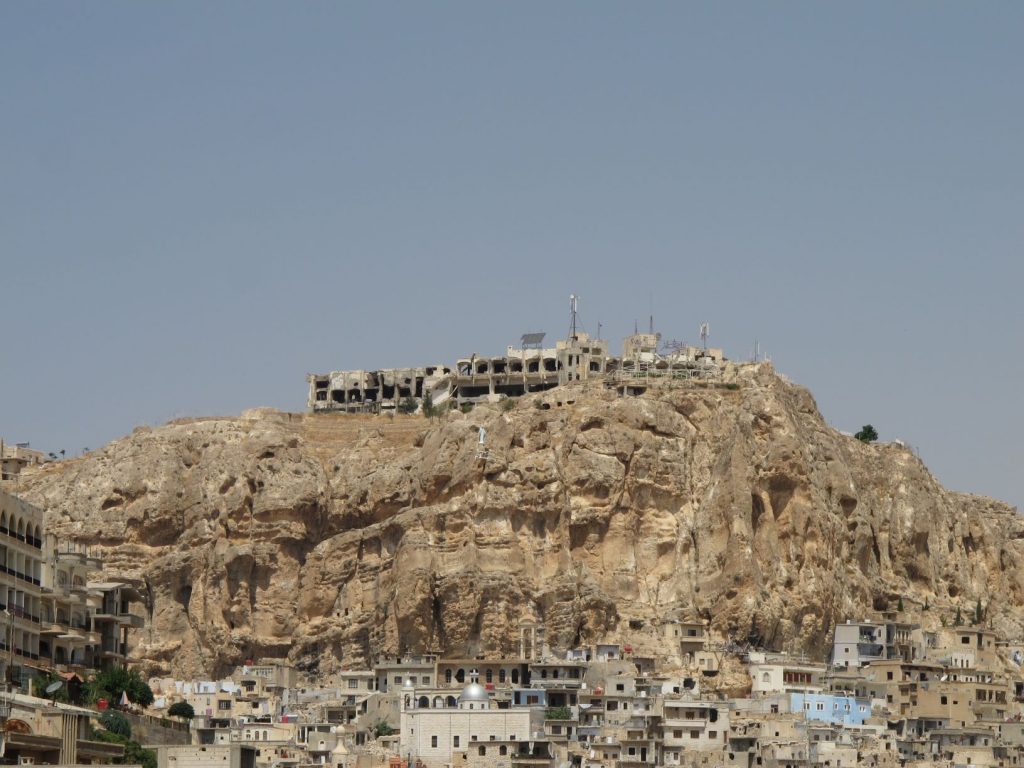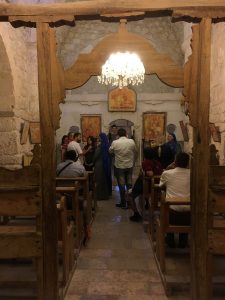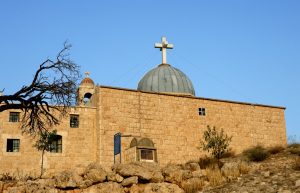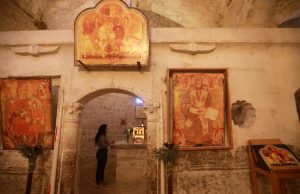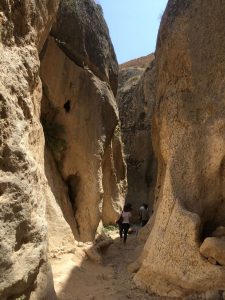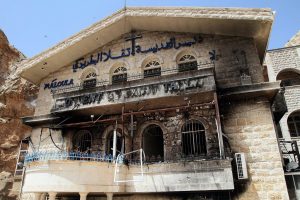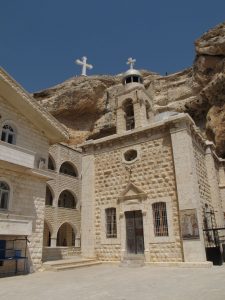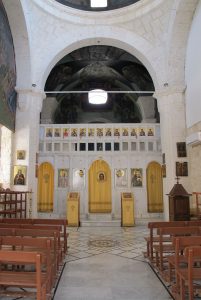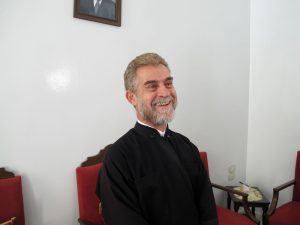Maaloula, Syria – Millions of foreign travelers used to flock to Syria before the war that broke out in 2011, and many would seek out the religious sites. One such site is the town of Maaloula, nested among the Qalamun Mountains, some 60 km northeast of Damascus. The place was visited on August 29 by journalists from news outlets – including ANBA – who visited the country at the invitation of Syria’s Ministry of Tourism.
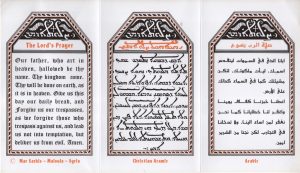
Maaloula, the subject of the second story in a series on Syria, is a one-of-a-kind place where Aramaic – the language employed in the Middle East during the time of Jesus Christ – is still spoken. Maaloula is Aramaic for “entrance,” in a probable reference to the fact that the village sits before a canyon that splits up the mountains from top to bottom.
The town is home to the convent and church of Saint Sergius (Deir Mar-Sarkis), built in the 4th century in honor of saints Sergius and Bacchus, two Syrian-born Christian martyrs. Tradition has it that both were soldiers for the Roman Empire, and were executed after refusing to renounce Christian faith in 297 AD, during the reign of emperor Maximian (286-305 AD).

The entrance to the complex is small, requiring one to crouch down to step inside. This is to prevent soldiers on horseback from entering. This, however, failed to prevent access by the Jihadi group Al-Nusra Front, which invaded Maaloula in 2013. The site was ransacked and seriously damaged in the war.
After entering the convent, one walks across a patio to get to the church, which is Greek Catholic (Melkite Greek) and comprises three altars with unique features. The structures’ stone lids are reminiscent of the altars in pagan temples, although in this case the holes designed to let the blood from sacrificed animals through aren’t there.
The day ANBA came to visit, a group was being given information by local resident Rita Wahba. According to her, 26 religious icons were stolen or damaged by the invaders, and the church was closed for years. The building was restored, but some of the icons on display are replicas donated by third parties.
According to Wahba, 17 Syrian soldiers died during the fighting to take back the city, but civilian casualties were few. “It was a miracle from God that the victims were so few,” she said. The Syrian army got Maaloula back in 2014, backed by Lebanon’s Hizbollah movement.
Wahba even recited a little sample from Psalm 135 in Aramaic for the tourists (watch the video at the end of this story).
(Story continues after photo gallery)
The visit to the church also prompted comments of the “It’s a small world” kind. The group that was visiting when the journalists arrived comprised a Syrian man and two young women, along with two nuns from Ecuador. An Argentinian journalist of Syrian descent immediately recognized the man as his cousin who lives in Aleppo.
Heading on
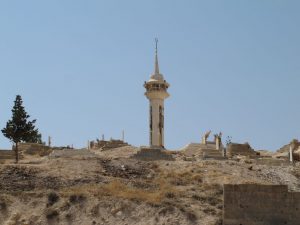
The destruction is also plain to see in buildings, like mosques and the Safir Hotel (pictured), set atop the hill that overlooks the village. Circling back through the ruins of the hotel and down the hill, one gets to the side of the canyon that the town was purportedly named after.
The trail leads to the Orthodox Monastery of Saint Thecla. This is where 12 nuns were kidnapped by the invaders in late 2013 and freed up a few months later in a prisoner switch negotiated by Qatar and Lebanon.
“The terrorists damaged this place. Terrorism came down on Syria, and Maaloula is part of Syria,” said priest Mathyo Toma, who oversees the Monastery. “They stole, broke and burned things. Whatever got broken can be restored, but what got burnt can’t,” he added. In Syria, the armed groups that clashed with the Army and – still do – are called “terrorists” and “savages.” The priest pointed out, however, that all Syrians share one future.
“The Christians are gone,” he said, since the locals fled during the invasion. The village used to have 5,000 residents before the war; now, it’s down to some 3,000, according to tour guides.
The Convent of Saint Thecla reopened in the second half of 2018 following restoration work. Father Mathyo said the situation is back to normal and visitors are showing up again. “We leave the past in the past and move on. ‘Kullu tamam,’” he said, an Arabic expression for “everything’s alright.”
(Story continues after photo gallery)
Legend has it that Saint Thecla, converted to Christianity by Paul the Apostle, was hunted down by her own family and by Roman soldiers. Trapped in the mountains, she prayed to God and a crack opened up in the rock, allowing her to escape. To honor her, the convent was built on one of the ends of the passage.
Our Lady

On the same day, ANBA also visited the Orthodox Convent of Saidnaya – Syriac for “Our Lady” (Said = Lady, Naya = Our) – where one of the four original icons of the Virgin believed to have been painted by Saint Luke, the Evangelist, is kept.
The name can also mean “Hunting Place” (Seid = Hunting, Dnaya = Place). This relates to the legend of how the place came to be. The Convent sits in an eponymous town 27 km southwest of Maaloula. The building was ordered carved into stone in the 6th century by Byzantine emperor Justinian, who had a vision of the saint there, as per tradition. The vision, the tale says, occurred while the emperor hunted a gazelle.
Many of Syria’s monasteries were used as stopovers by pilgrims headed for the Holy Land.
The journey continues on Thursday (11) in Homs and Palmyra.
*ANBA traveled at the invitation of Syria’s Ministry of Tourism. Translated by Gabriel Pomerancblum



